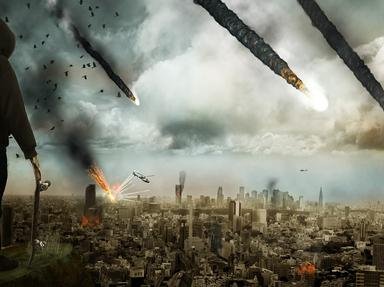Quiz Answer Key and Fun Facts
1. The 1916 Danish film "Verdens Undergang" (The End of the World) drew inspiration from which 1910 event?
2. Abel Gance's 1931 film "La Fin du Monde" (The End of the World) has a stock market crash as one of its central themes.
3. The events at the end of World War II created new fears for the public that film makers seized upon. With this in mind, what calamity were Gregory Peck and Ava Gardner trying to deal with in the 1959 film "On the Beach"?
4. The 1950s marked a time when the United States intensified its nuclear programme which created the awkward questions as to what the effects of all this radiation will be. For filmmakers it created the opportunity to give birth to a new age of monsters. Which one of the following mutations was NOT created in the 1950s?
5. The intensification of the Cold War brought a new kit-bag of fear and paranoia that filmmakers readily exploited. Which of the following films from the 1960s featured Slim Pickens riding a H-Bomb toward its detonation?
6. A "virus" destroys wheat and rice in the 1970 film "No Blade of Grass", a film that a number of scholars indicate was influenced by which of the following events of that time?
7. Harry Harrison's 1966 novel "Make Room! Make Room!" took advantage of a burgeoning environmental movement, and his story, that was filled with the issues of over-population and pollution, was translated into which of the following films starring Charlton Heston?
8. Charlton Heston surfaces as the last real human being on Earth in 1971's "The Omega Man". The rest of the world's population has been affected, ostensibly, by which of the following?
9. Which 1973 event created a portent that would, six years later, be reflected in George Miller's apocalyptic film "Mad Max"?
10. Don't be daft, machines will never replace humans! However, which 1984 James Cameron film foreshadowed exactly that scenario?
11. At the start of the 1990s the Cold War came to an end and filmmakers now needed another way for the Earth to end. They looked to space. Which of the following films featured aliens hell bent on wiping out humanity?
12. In the prelude to the arrival of Halley's Comet in 1986, which cheesy 1984 film was released that signaled the world's demise by space dust, would be panned by critics and would go on to become a cult classic?
13. At the time "The Matrix" (1999) was released, the world's population was experiencing anxiety over which of the following events?
14. In 2006 the film "An Inconvenient Truth" was launched on the public preaching a message about which of the following topics?
15. Roland Emmerich's 2009 masterpiece "2012" was based on which of the following events?
Source: Author
pollucci19
This quiz was reviewed by FunTrivia editor
skunkee before going online.
Any errors found in FunTrivia content are routinely corrected through our feedback system.
